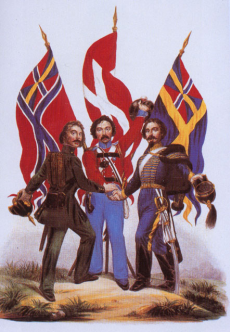
What is Scandinavia? Some people think it’s a country (I know I used to when I was a child!) Others might think the word means all of Northern Europe, including Finland, Norway, Sweden, Denmark, and possibly even the island nations of Greenland and Iceland. Actually it refers to the historical, cultural and linguistic area of Norway, Sweden and Denmark. Norway and Sweden are located on the Scandinavian Peninsula, which confusingly includes northern Finland as well. Denmark is to the south on the Jutland peninsula and the Danish Islands.
The word Scandinavia comes from Scania, a small province at the very tip of the Scandinavian Peninsula, part of modern Sweden. Reconstructed to its North Germanic stem, the word could mean “dangerous island,” possibly in reference to the sandbanks around Scania which made it very difficult for ships to land. The area was thought to be an island as it was very difficult to travel to the far north to confirm its status as a peninsula.
The terms “Scandinavia” and “Scandinavian peoples” entered common use in the 19th century with Pan-Scandinavism. This was a literary and political movement which promoted co-operation between the three kingdoms, and emphasised their shared history, cultural heritage, Nordic mythology and common linguistic root in Old Norse. The latter was a very strong argument, as Norwegian, Swedish and Danish are all North Germanic languages which are so closely related that they form a dialect continuum in which they are all mutually intelligible. Any North Germanic language speaker is able to understand any of the other tongues, as each language differs only slightly from its neighbour. Followers of Scandinavism brought out joint periodicals, or magazines, and formed societies to support unity between the languages and their literature.
Political Scandinavism pushed for the unification of the three kingdoms, and was instigated by Danish and Swedish university students based in Scania in the 1830s and 40s. One of their supporters was the Danish author Hans Christian Anderson, famous for his fairytales, who had visited Sweden in 1837. Following his visit he wrote a poem entitled ‘I am a Scandinavian’ which he wanted set to music to become a new national anthem. At first the Scandinavism movement aroused the suspicion of the political establishment in each country, but it soon gained support from liberal newspapers. Many people saw it as a way to counter the growing conservative powers in Europe.
There was a historical precedent for union between the nations. All three had been joined in 1387 under Queen Margaret I of Denmark, in the Kalmar Union, which included Sweden’s possession of Finland and Norway’s overseas territories of Iceland, Greenland, the Faroe Islands and the Northern Isles. The Kalmar Union came to an end in 1523 when Sweden left, leaving Norway and Denmark in a personal union under Danish hegemony. This continued until 1814, when a military campaign by Swedish king Charles XIII against Norway ended with the latter being forced into a personal union under Sweden. Gaining Norway was seen as a compensation for the Swedish loss of Finland to Russia in 1809. Denmark, meanwhile, kept all of Norway’s overseas possessions.
In 1844 Oscar I became king of Sweden and Norway, and made followers of Scandinavism more optimistic about the success of their movement when he sought to improve relations with Denmark. He offered military support to them during the First Schleswig War in 1848 when Prussia, a growing empire at the time, fought the Danes over the area of land linking modern Germany to the Danish peninsula. This was an important region as it provided a trade link between the North and Baltic seas. However, in 1864 when the Second Schleswig War began the Swedish government were unwilling to oppose the now incredibly powerful Prussian Empire, and refused to come to Denmark’s aid. This saw the effective end of the Scandinavism movement, and there were no further official unions between the three countries. The Sweden-Norway union came to an end in 1905 when Norwegian calls for independence were finally met.
An unlikely testament to the Scandinavism movement is Dannevirke, a small town in North Island, New Zealand. It was founded in 1872 by followers of the movement, and named after Danevirke, an ancient set of fortifications located in the Schleswig region. Dating from 500AD, these were expanded by the Vikings, and became an important symbol for the Danish people. Consequently their loss in 1864 was a severe blow to the Danes, and the naming of the town provided some consolation.
Image: https://upload.wikimedia.org/wikipedia/commons/7/78/Skandinavism.jpg

0 Comment:
Be the first one to comment on this article.